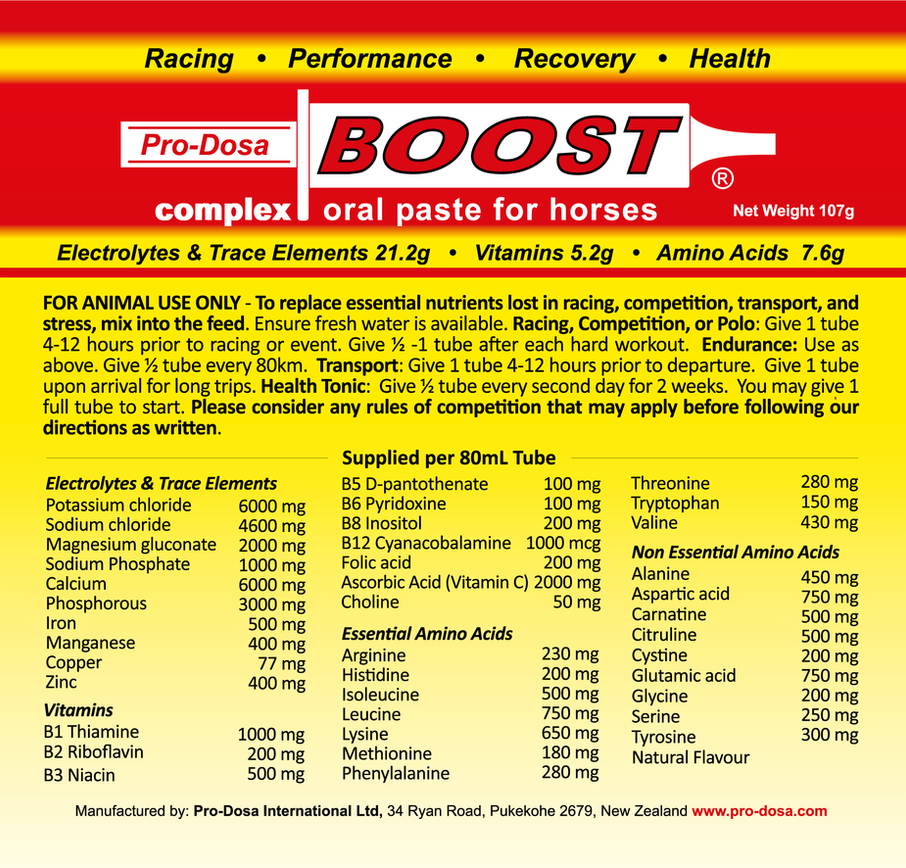適切な材料が揃っていますか、バランスは適切ですか?
ラベルを読む際には、栄養成分の完全性、バランス、形状、投与量など、栄養成分のあらゆる側面を考慮することが重要です。そうすることで、あなたの馬の栄養必要量と成分を比較することができます。
完全
代謝は非常に複雑で、最適に機能するには幅広い必須栄養素が必要です。2、3種類の栄養素を摂取するだけでは、パフォーマンス、回復、健康、そして代謝をサポートすることはできません。ある栄養素を多く摂取しても、他の栄養素の不足を補うことはできません。もし家中の食料が尽きてしまい、大きな袋に入った塩だけで生活しようとしたら、長くは持ちません。
バランス
栄養素間のバランスも同様に重要です。ある栄養素は、他の栄養素の吸収と機能に必須です。(これらの補助的・協力的な栄養素は補因子と呼ばれます。)ある栄養素の摂取量が多すぎたり少なすぎたりすると、他の栄養素の欠乏や毒性を引き起こす可能性があります。したがって、バランスの崩れは健康、パフォーマンス、そして回復に悪影響を及ぼす可能性があります。少なくとも、飼料やサプリメントのバランスが崩れると、製品の効果が損なわれる可能性があります。
例えば、ビタミンCは腸管からの鉄の吸収に不可欠です。ビタミンCがなければ、鉄は腸管を通り抜け、便として排出されてしまいます。一方、ビタミンEは鉄と悪影響を及ぼします。ビタミンEは鉄と結合して吸収を阻害し、多くの鉄が無駄になってしまいます。そのため、馬が食物中の鉄を効果的に利用するために、ビタミンCを併用し、ビタミンEは併用せずに投与する必要があります。鉄分のバランスは、亜鉛、マンガン、コバルト、銅とも密接に関連しています。
一般的な給餌比率
| 栄養素 | 比率 |
| Ca:P | 1-2:1 |
| Zn:Mn | 0.7-1.1 |
| Zn:Cu | 3-4:1 |
| Fe:Cu | 4:1 |
ビタミンB群は、互いに最適なバランスで摂取することで、より効果的に作用することが知られています。ビタミンB群は、エネルギー産生、赤血球産生、被毛と皮膚の状態、神経細胞の機能、そして食欲に重要な多くの代謝経路において協調して作用します。ビタミンB群全体が最適なバランスで供給されていない場合、特定のビタミンB群の投与量を増やしても、健康状態やパフォーマンスの改善が見られない可能性があります。
アミノ酸は栄養バランスの重要性を示すもう一つの良い例です。これについては後ほど詳しく説明します。 READING LABELS PART 4 飼料の評価についてですが、その間に、トップラインについてブログに投稿したJ. スチュワート博士の記事をお読みください。この記事でジェニーは、飼料中のアミノ酸バランスがタンパク質の量と同じくらい重要である理由を説明しています。アミノ酸のバランスが崩れると、馬の体内でタンパク質や筋肉細胞の生成に利用できる飼料中のタンパク質の量が制限され、タンパク質合成に利用できない無駄なアミノ酸は腎臓に負担をかけ、体温と心拍数を上昇させます。
バイオアベイラビリティ
バイオアベイラビリティとは、栄養素の吸収性と利用性を指します。これは製品中の栄養素の組成やバランスにも一部関連していますが、最も一般的には、各栄養素がどのような形で提供されるかを指します。
いくつかの形態は他の形態よりも容易に吸収され利用されます。たとえば、微量元素のクロムはいくつかの異なる形態で存在します。車のクロムバンパーに含まれる形態のクロムは、消化されにくいですが、酵母に組み込まれた形態のクロムは非常に容易に吸収され、細胞によって利用されます。カルシウム、マグネシウム、鉄、コバルト、銅、亜鉛、セレン、マンガンなどのミネラルは、さまざまな形態で提供され、それぞれ生物学的利用能が異なります。一般に、無機形態の栄養素は有機形態よりも利用率が低くなりますが、これは常に信頼できる規則であるとは限りません。酸化亜鉛は亜鉛の最も生物学的利用能の高い形態の 1 つですが、亜鉛キレートは大きな分子を形成し、非常に不活性のままです。ただし、ほとんどの場合、グルコン酸塩、乳酸塩、アミノ酸またはタンパク質複合体として提供されるミネラルはよく利用されます。
ラベルを読む際は、成分の量が記載されているのか、活性分子の量が記載されているのかに注意する必要があります。例えば、鉄バイオプレックス(鉄はアミノ酸またはタンパク質に結合しています)には、鉄分が約10%しか含まれていません。ラベルに「1回分あたり400mgの鉄分を含む」と記載されている場合、1回分には約4000mgの鉄バイオプレックスが含まれており、非常によく吸収され利用される鉄分が400mg含まれていることを意味します。一方、「1回分あたり400mgの鉄バイオプレックスを含む」と記載されている場合、実際には鉄分は40mgしか含まれていません。ラベルを読んで製品を比較する際には、これらの詳細をよく読んでください。
これでパート2は完了です!
サプリメントのラベルの読み方 – パート1と2をまとめると
From Part 1: ラベルが分かりやすく、馬に何を与えているのか一目でわかる場合、メーカーは自社の配合に誇りを持っており、厳しい審査にも耐えられると考えている可能性が高いです。もし、何を与えているのかを計算するのに多くの計算をしなければならない場合は、配合があまり良くない可能性が高いです。いずれにせよ、棚にある中で最も安い、あるいは見た目が良い製品を選ぶ前に、時間をかけて計算し、比較検討するようにしてください。
From Part 2: ラベルを読むときは、馬の栄養要件に関連して、バランス、形状、投与量など、栄養成分のあらゆる側面を考慮することが重要です。
ラベルを読むブログの第3回をぜひ読んでみてください Reading Labels Part 3 – Product Quality Management. This looks at the quality of ingredients and manufacture.



